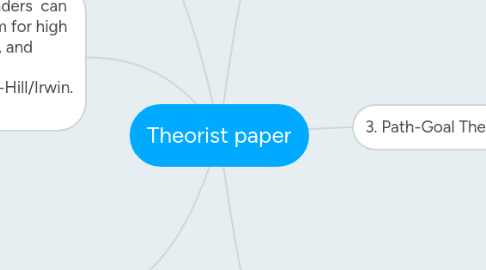Theorist paper
por Jessica Chan

1. Learning Theory Theories that focus on increasing employee motivation and performance by linking the outcomes that employees receive to the performance of desired behaviors and the attainment of goals. Jones (2014-01-07). Essentials of Contemporary Management (Page 489). McGraw-Hill/Irwin. Kindle Edition.
2. PATH–GOAL THEORY A contingency model of leadership proposing that leaders can motivate subordinates by identifying their desired outcomes, rewarding them for high performance and the attainment of work goals with these desired outcomes, and clarifying for them the paths leading to the attainment of work goals. Jones (2014-01-07). Essentials of Contemporary Management (Page 491). McGraw-Hill/Irwin. Kindle Edition.
3. 2.Social Learning Theory
3.1. Albert Bandura Social learning theory (Albert Bandura) posits that learning is a cognitive process that takes place in a social context and can occur purely through observation or direct instruction, even in the absence of motor reproduction or direct reinforcement.[1] In addition to the observation of behavior, learning also occurs through the observation of rewards and punishments, a process known as vicarious reinforcement. The theory expands on traditional behavioral theories, in which behavior is governed solely by reinforcements, by placing emphasis on the important roles of various internal processes in the learning individual.
3.2. Social Learning Theory - proposes that motivation results not only from direct experience of rewards and punishments but also from a person’s thoughts and beliefs. Social learning theory extends operant conditioning’s contribution to managers’ understanding of motivation by explaining (1) how people can be motivated by observing other people performing a behavior and being reinforced for doing so ( vicarious learning), (2) how people can be motivated to control their behavior themselves ( self-reinforcement), and (3) how people’s beliefs about their ability to successfully perform a behavior affect motivation ( self-efficacy ). 68 We look briefly at each of these motivators.
4. 1. operant Conditioning Theory
4.1. Developed by psychologist B.F Skinner
4.1.1. OPERANT CONDITIONING THEORY The theory that people learn to perform behaviors that lead to desired consequences and learn not to perform behaviors that lead to undesired consequences.
4.1.2. B.F Skinner-Burrhus Frederic Skinner, better known as B.F. Skinner, is possibly the most widely known and influential behaviorist psychologist. He was not, however, a pioneer in the field, but developed the ideas of his predecessors, such as Ivan Pavlov and John B. Watson, by subjecting theories of behaviorism to rigorous experimental scrutiny in order to arrive at his controversial stance of "radical behaviorism."
5. 3. Path-Goal Theory
5.1. Psychologist, Robert House, developed Path-Goal Theory in 1971, and then redefined and updated it in a 1996 article in The Leadership Quarterly. Let's look at some of the elements of the theory.
5.2. PATH–GOAL THEORY A contingency model of leadership proposing that leaders can motivate subordinates by identifying their desired outcomes, rewarding them for high performance and the attainment of work goals with these desired outcomes, and clarifying for them the paths leading to the attainment of work goals.
5.3. The premise of path–goal theory is that effective leaders motivate subordinates to achieve goals by (1) clearly identifying the outcomes that subordinates are trying to obtain from the workplace, (2) rewarding subordinates with these outcomes for high performance and the attainment of work goals, and (3) clarifying for subordinates the paths leading to the attainment of work goals. Path–goal theory is a contingency model because it proposes that the steps managers should take to motivate subordinates depend on both the nature of the subordinates and the type of work they do. Path–goal theory identifies four kinds of leadership behaviors that motivate subordinates: • Directive behaviors are similar to initiating structure and include setting goals, assigning tasks, showing subordinates how to complete tasks, and taking concrete steps to improve performance. • Supportive behaviors are similar to consideration and include expressing concern for subordinates and looking out for their best interests. • Participative behaviors give subordinates a say in matters and decisions that affect them. • Achievement-oriented behaviors motivate subordinates to perform at the highest level possible by, for example, setting challenging Jones (2014-01-07). Essentials of Contemporary Management (Page 342). McGraw-Hill/Irwin. Kindle Edition.
6. 4.Equity Theory
6.1. Equity theory is a theory of motivation that concentrates on people’s perceptions of the fairness of their work outcomes relative to, or in proportion to, their work inputs. Equity theory complements expectancy and need theories by focusing on how people perceive the relationship between the outcomes they receive from their jobs and organizations and the inputs they contribute. Equity theory was formulated in the 1960s by J. Stacy Adams, who stressed that what is important in determining motivation is the relative rather than the absolute levels of outcomes a person receives and inputs a person contributes. Specifically, motivation is influenced by the comparison of one’s own outcome–input ratio with the outcome– input ratio of a referent. 50 The referent could be another person or a group of people who are perceived to be similar to oneself; the referent also could be oneself in a previous job or one’s expectations about what outcome–input ratios should be. In a comparison of one’s own outcome–input ratio to a referent’s ratio, one’s perceptions of outcomes and inputs (not any objective indicator of them) are key. Jones (2014-01-07). Essentials of Contemporary Management (Page 308). McGraw-Hill/Irwin. Kindle Edition.



